Réunion |
|
|
|
| Übersicht – Contents: | |
Réunion |
|
|
|
| Übersicht – Contents: | |
Flaggen – Flags: |
|
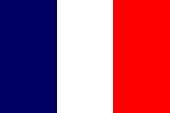 |
die Flagge
Frankreichs |
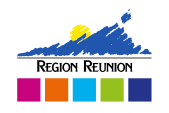 |
Flagge des Regionalrats |
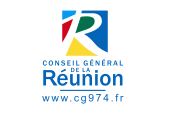 |
Flagge des Generalrats |
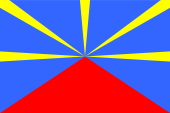 |
seit/since 2013,   |
inoffizielle Flaggen – unofficial Flags: |
|
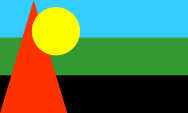 |
seit/since 1984, |
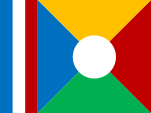 |
seit/since 1996,   |
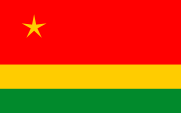 |
seit/since 2008, |
historische Flaggen – historical Flags: |
|
 |
2003-2013,   |
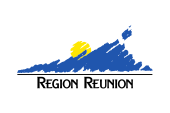 |
1990-2015,   |
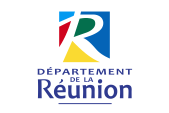 |
bis/to 2015, |
| Alle französischen Kolonien, hatten über lange Zeit keine eigene Flagge. Es musste die französische Trikolore gehisst werden. Das gilt im Prinzip bis heute. Der Status der Kolonien änderte sich über die Jahre. Einige sind heute Überseedepartements, und damit ein ultraperipherischer Teil Frankreichs und auch der EU; andere sind Überseegemeinschaften, die autonom sind, und nicht Teil Frankreichs oder der EU. Überseedepartements gehören – nicht wie die Departements des Mutterlandes – zu keiner administrativen Region Frankreichs, sondern bilden eine eigene Region. |
All French colonies had no own flag over a long period. It had to be hoisted the French tricolor. This in principle usual until today.
The status of the colonies changed over the years. Some of them are now overseas departments, and thus a ultraperipheric part of France and of the EU; others are overseas communities, autonomous, and not a part of France or the EU. Overseas departments belong – in contrast to the departments of the motherland – to no administrative region of France, they are a separate region. |
| Die Gebietskörperschaft muss demzufolge offiziell die Flagge Frankreichs verwenden, jedoch können der Generalrat als oberstes gewähltes Kollegialorgan eines französischen Départements und auch der Regionalrat als oberstes gewähltes Kollegialorgan einer französischen Region eigene Flaggen haben. | The territorial entity has therefore officially to use the flag of France. However, the General Council as the highest elected collegial body of a French Department and the Regional Council as the highest elected collegial body of a French Region can have their own flags. |
| Diese Départements- und Regionsflaggen haben allerdings oft das Erscheinungsbild von Firmenflaggen mit Logos oder gar stilisierten Bildern, wirken lieblos, unhistorisch, technokratisch und modernistisch, denn im streng zentralistischen Frankreich wird jedwede Regionalität oder gar ein Bezug zur Geschichte vermieden. Darum sind diese Regions-Logo-Flaggen unbeliebt und werden kaum benutzt. | These flags of departments and regions, however, have oftenly the appearance of company flags with logos or even stylized images, appear carelessly, ahistorical, technocratic and modernist, because in the strictly centralist France is avoided any regionalism or even a historical subscription. Because of that these logo flags of regions are unpopular and are rarely used. |
| Eine inoffizielle Flagge hat Réunion eigentlich nicht, zumindest keine die sich als Erkennungszeichen durchgesetzt hätte. Es gibt lediglich mehrere Vorschläge von Parteien und Gruppierungen die auch teilweise die Unabhängigkeit anstreben, die als Flagge verwendet werden. Bereits 1984 schlug die MLK (Mouvman Lantant Koudmin Association) eine Flage vor. Sie zeigt drei horizontalen Streifen in Hellblau (Himmel, Meer), Grün (Vegetation, Hoffnung, Freiheit) und Schwarz (Sklaverei). Am Mast erhebt sich ein rotes Dreieck (Vulkanismus) mit einer gelben Scheibe (Sonne). Die fünf Farben sollen auch auf den Ursprung der Bevölkerung der Insel von allen fünf Kontinenten der Erde hinweisen. Die LPLP (Lorganizasyon popilèr po libèr nout peï) schlug 1986 eine Flagge vor, die drei horizontalen Streifen in Rot (Sklaverei), Gelb und Grün (Freiheit) zeigte. Der verbreiterte rote Streifen zeigt einen fünfzackigen gelben Stern in der Oberecke, der für fünf auf der Insel lebende Völker stehen soll: Kaf, Yab, Malbar, Zarab und Shinwa. Diese Flagge wurde 2008 als Flagge für ein eventuell unabhängiges Réunion anerkannt. Die Farbenkombination von Grün, Gelb und Rot sind die Panafrikanischen Farben: Etwa 1900 setzte die Panafrika-Bewegung ein, die Gemeinsamkeiten aller Menschen mit schwarzer Hautfarbe hervorheben wollte. Der Farbendreiklang Grün-Gelb-Rot, den viele afrikanische und auch amerikanische Staaten nach Erlangung ihrer Unabhängigkeit in ihre Flaggen übernahmen, steht für die politische Einheit Afrikas, ja aller Schwarzen. Das erste Land war Ghana im Jahr 1957. Als Ursprung gelten die Landesfarben von Athiopien (Abessinien), dem ältesten unabhängigen Staat Afrikas. Im Jahre 1996 schlug die APDR (L'Association pour le drapeau de La Réunion) eine Flagge vor, deren Hauptfeld vierfach diagonal geteilt war, in den Farben Gold (Inder, Sonne), Rot (Chinesen, Vulkanismus), Grün (Afrikaner) und Blau (Europäer), in der Mitte belegt mit einer weißen Scheibe (Frieden, Harmonie). Am Rand sind in einem schmalen Streifen die Farben Frankreichs zu sehen. Im Jahre 2003 schlug die PRG (Parti radical de gauche, Radikale Linkspartei) eine Flagge vor, die "Der strahlende Vulkan" genannt wird. Sie zeigt in der Bases ein breites rotes Dreieck (der Vulkan Piton de la Fournaise) auf blauem Grund, dessen Spitze fünf gelbe Strahlen ausstrahlt. Rot steht für das Blut, das in der Sklaverei vergossen wurde, Blau steht für Himmel und Milde, Gelb steht für die Sonne und Klarheit. Die Strahlen symbolisieren die Bevölkerung, die im Laufe der Jahrhunderte Reunion aus fünf Kontinenten bevölkerte. Diese Flagge konnte sich in vielen Gemeinden durchsetzen, wurde bei Sportveranstaltungen verwendet und ihr Symbolismus auch auf eine 10-Euro-Münze geprägt. Die Mehrheit der Bevölkerung steht der Flagge ablehnend oder gleichgültig gegenüber und sie ist nicht offiziell bestätigt. |
Réunion does not actually have an unofficial flag, at least not one that
has become established as a distinctive sign. There are only several
proposals from parties and groups that are also partly striving for
independence. which are used as flags. Already in 1984, the MLK (Mouvman Lantant Koudmin Association) proposed a flag. It shows three horizontal stripes in light blue (sky, sea), green (vegetation, hope, freedom) and black (slavery). At the mast rises a red triangle (volcanism) with a yellow disc (sun). The five colours are also meant to indicate the origin of the island's population from all five continents of the earth. The LPLP (Lorganizasyon popilèr po libèr nout peï) proposed a flag in 1986 that showed three horizontal stripes in red (slavery), yellow and green (freedom). The broadened red stripe shows a five-pointed yellow star in the upper corner, which is supposed to stand for five peoples living on the island: Kaf, Yab, Malbar, Zarab and Shinwa. This flag was recognised in 2008 as the flag for a possibly independent Réunion. The combination of the colours green, yellow and red is called the Panafrican Colours: Perhaps in 1900 was the beginning of the Panafrica-Movement, wich wants to emphasize the commons of all people with black skin. The colour-triad green-yellow-red, wich is used by many african and even american countries in their flags after the independence, stands for the political unity of Africa, of all black people. The first country was Ghana in 1957. As the origin apply the colours of Ethiopia (Abessinia), the oldest independent state in Africa. In 1996, the APDR (L'Association pour le drapeau de La Réunion) proposed a flag whose main field was divided four times diagonally, in the colours gold (Indians, sun), red (Chinese, volcanic), green (Africans) and blue (Europeans), in the middle covered with a white disc (peace, harmony). At the edge, close to the mast, the colours of France can be seen in a narrow stripe. In 2003, the PRG (Parti radical de gauche, Radical Left Party) proposed a flag called "The Radiant Volcano". It shows in the bases a broad red triangle (the volcano Piton de la Fournaise) on a blue background, the peak of it emits five yellow rays. Red stands for the blood spilled in slavery, blue for sky and mildness, yellow for the sun and clarity. The rays symbolise the peoples that populated Réunion from five continents over the centuries. This flag has gained acceptance in many communities, has been used at sporting events and its symbolism has also been embossed on a 10-euro coin. The majority of the population is hostile or indifferent to the flag and it is not officially confirmed. |
| Quelle/Source: Wikipedia (FR), FOTW, World Statesmen | |
| Wappen – Coat of arms: | |
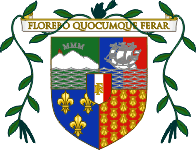 |
seit/since 1925 Wappen von Réunion – coat of arms of Réunion, Quelle/Source nach/by: Wikipedia (FR), Superbenjamin, CC BY-SA 4.0, via Wikimedia Commons |
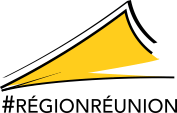 |
Logo von Réunion – Logo of Réunion, Quelle/Source nach/by: Wikipedia (FR) |
| Das Wappen von Réunion ist ein gevierteilter Schild, der mit einem Herzschild belegt ist. Feld eins zeigt in Grün und Weiß eine Küstenlandschaft mit Bergen und drei Buchstaben "MMM", die römische Zahl 3000, die für die Höhe des höchsten Berges der Insel steht. Feld zwei ist blau-rot gespalten, darauf ein weißes Schiff unter vollen Segeln. Feld drei zeigt drei goldene Lilien auf Blau, die alte französische Heraldik, ein Hinweis darauf, dass die Insel seit 1649 französischer Besitz ist. Feld vier ist rot und ist mit goldenen Bienen bestreut. Die goldenen Bienen waren ein bei Napoléon I. beliebtes Zeichen der Anerkennung, dass er verdienstvollen Personen oder auch Inseln und Ländern in das Wappen gegeben hat. Ein Hinweis darauf, dass die Insel zwischen 1793 und 1814 "Île Bonaparte" geheißen hat. Der Herzschild bezieht sich auf das moderne Frankreich und zeigt die Farben der französichen Trikolore: Blau, Weiß und Rot, sowie im weißen Feld die verschlungenen Buchstaben R und F, die für "République française" stehen. Das Wappen wurde 1925 eingeführt und ist eine Kreation von Laure Fernando. Die Inschrift über dem Wappen lautet "Florebo quocumque ferar", was übersetzt heißt: "Ich werde blühen, wohin man mich auch immer bringen möge" | The coat of arms of Réunion is a quartered shield which is
topped by a smaller shield. Field No. 1 shows in green and white, a coastal landscape with mountains and three letters "MMM", the Roman numeral 3000, which
points out to the height of the highest peak of the island. Field No. 2 is splited
in blue-red, on it a white ship under full sails. Field No. 3 three shows three golden lilies on blue, the old French Heraldry, a an indication that the island
is a French possession since 1649. Field No. 4 is red and is sprinkled with golden bees. The golden bees
had been a at Napoléon I. popular token of appreciation, which he has
avarded meritorious persons or islands and countries into their coats of
arms. An indication that the island was called "Ile Bonaparte" between 1793
and 1814. The heart shield refers to modern France and displays the colours of the French tricolor: blue, white and red, and in the white field the intertwined letters R and F, which stand for "République française". The coat of arms was introduced in 1925 and is the work of Laure Fernando. The inscription above the coat of arms is "Florebo quocumque ferar", what means "I will flourish wherever I will be brought". |
| Quelle/Source: Wikipedia (FR) | |
| Landkarten – Maps: |
|
|
|
|
| Zahlen und Fakten – Numbers and Facts: | |
|
|
|
|
|
|
|
|
|
|
|
|
|
|
|
|
|
|
| Quelle/Source: Wikipedia (D), Discovery '97 | |
|
1507 · Entdeckung der unbewohnten Insel durch den portugiesischen Seefahrer Pedro Mascarenhas, er nennt die Insel "Santa Apolonia", kurze Zeit später werden Apolonia, Mauritius und Rodrigues zum geographischen Begriff "Maskarenen" zusammengefasst 17. Jahrhundert · die Insel wird Zwischenstation englischer und niederländischer Schiffe auf dem Seeweg nach Indien 1640 · Franzosen landen auf der Insel, sie nennen sie "Île Bourbon" (Bourbon-Insel, der französische König entstammt dem Adelshaus Bourbon) 1649 · Frankreich annektiert die Insel, sie wird zur französischen Kolonie 1665 · beginnende französische Besiedlung 1793 · Umbenennung in "Île de la Réunion" 1802 · Wiedereinführung der Sklaverei durch Napoléon I., daraufhin wird die Insel ihm zu Ehren in "Île Bonaparte" umbenannt 1810 · britische Truppen besetzen die Insel und geben ihr den alten Namen "Île Bourbon" wieder zurück 1848 · Abschaffung der Sklaverei, die Insel wird wieder in "Île de la Réunion" zurückbenannt 1946 · Réunion wird Überseedepartement 1972 · Frankreich gewährt begrenzte Autonomie 1982 · Réunion wird Überseeregion 1997 · Réunion wird "région ultrapériphérique", ein Gebiet in äußerster Randlage der Europäischen Union 2005 · die ehemaligen Dependenzen Îles Éparses werden der Verwaltung von Réunion entzogen und dem Verwalter der Französischen Süd- und Antarktisgebiete (TAAF) unterstellt 2007 · die Îles Éparses werden den Französischen Süd- und Antarktisgebieten (TAAF) angeschlossen |
|
1507 · discovery of the uninhabitet island by the
Portuguese navigator Pedro Mascarenhas, he calls the island "Santa
Apolonia", a short time later Apolonia, Mauritius and Rodrigues became
summarized to the geographical term "Mascarenas" 17th century · the island is a stopover for English and Dutch ships on the sea route to India 1640 · the French debark on the island, they call it "Île Bourbon" (Bourbon Island, the French king comes from the noble House of Bourbon) 1649 · France annexes the island, it becomes a French colony 1665 · beginning French settlement 1793 · rename in "Île de la Réunion" 1802 · reintroduction of slavery by Napoléon I., then the island was renamed in "Ile Bonaparte" to honour him 1810 · British troops occupy the island and give it the old name "Ile Bourbon" back 1848 · abolition of slavery, the island gets back again its old name "Île de la Réunion" 1946 · Réunion is an overseas department 1972 · Frankreich grants limited autonomy 1982 · Réunion is an overseas region 1997 · Réunion is "région ultrapériphérique", an area in outermost regions of the European Union 2005 · the former dependencies of the (Scattered Islands) Îles Éparses become withdrawn from administration of Réunion and subordinated to the manager of the French Southern and Antarctic Lands (TAAF) 2007 · the Scattered Islands (Îles Éparses) become annexed to the French Southern and Antarctic Lands (TAAF) |
| Quelle/Source: Wikipedia (D), Discovery '97 |
| Îles Éparses - Scattered Islands: | |
| Die Îles Éparses sind französische Besitzungen und ehemalige Dependenzen von Réunion. Sie liegen vor allem in Westen und Norden von Madagaskar. Seit 2005 werden sie vom Verwalter der Kolonie "Französische Süd- und Antarktisgebiete, (TAAF)" verwaltet, und wurden 2007 den TAAF angeschlossen. | The Scattered Islands are French possessions and former dependencies of Réunion. They are mainly placed in the west and north of Madagascar. Since 2005, they are managed by the administrator of the colony "French Southern and Antarctic Lands (TAAF)", and in 2007 they became fully annexed to the TAAF. |
|
|
| Quelle/Source: Wikipedia (D) | |
| Die Insel trug schon viele Namen, so "Santa Apolonia", zu Ehren der heiligen Apolonia, an derem Tag Pedro Mascarenhas die Insel entdeckte. Die Franzosen, die als erste auf der Insel siedelten, nannten Sie nach der Dynastie ihre Königs "Île Bourbon". Zwischen 1802 und 1810 hieß die Insel zu Ehren von Napoléon I. "Ile Bonaparte". Wahrscheinlich im Zusammenhang mit Ereignissen der Französischen Revolution des Jahres 1792 wurde die Insel in "Île de la Réunion" umbenannt, was "Treffen" bedeutet, jedoch ist in Vergessenheit geraten, welches Treffen eigentlich gemeint war. | The island
had have a lot of names, so "Santa Apolonia", in honor of St. Apolonia, at whose day Pedro Mascarenhas discovered the island.
The French, the first settlers on the island, named it after the dynasty their king "Île Bourbon". Between 1802 and 1810 the island was called "Ile Bonaparte" in honor of Napoléon I. Probably in connection with events of the French Revolution in 1792, the island was renamed in "Île de la Réunion", what means something like "meeting", but it is now forgotten which meeting was actually meant. |
| Quelle/Source: Wikipedia (D) | |